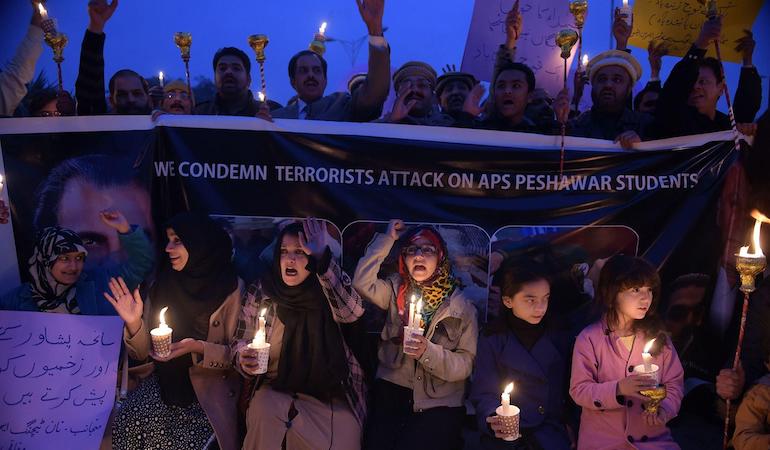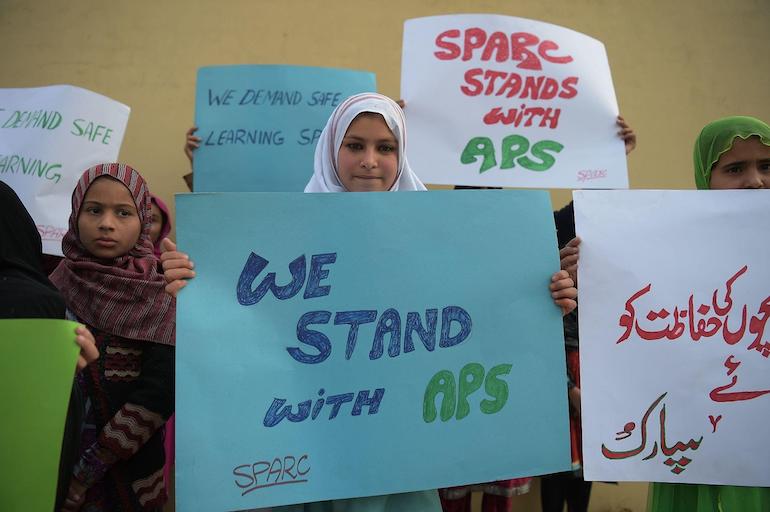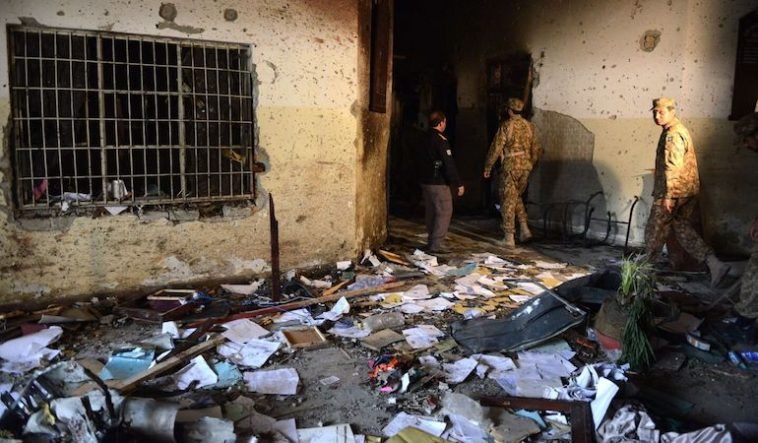Darkest Day in Pakistan’s History
The Army Public School in the Pakistani city of Peshawar was the target of a terrorist attack on December 16, 2014, carried out by six gunmen who were (TTP) members. The terrorists, who were all foreigners and included one Chechen, three Arabs, and two Afghans, entered the school and began shooting at students and staff, killing 149 people overall, including 132 students between the ages of eight and eighteen, making it the fifth deadliest school massacre in history. Pakistan launched a rescue operation in retribution, which was carried out by the Special Services Group (SSG) of the Pakistan Army’s special forces, who killed all six terrorists and rescued 960 people. Pakistan created the National Action Plan in the long run to combat terrorism.
The Beslan school hostage crisis that took place in the Russian Federation’s North Ossetia-Alania region in 2004 is said to have been a major influence on the character and planning of the attack, according to numerous news organizations and pundits.
In response to the attacks, Pakistan lifted its moratorium on the death penalty, increased funding for the War in North-West Pakistan, and amended its constitution to allow military tribunals to trial civilians. Pakistan hanged four extremists responsible for the Peshawar massacre on December 2, 2015. On August 7, 2022, a roadside mine in Afghanistan killed Omar Khorasani, the attack’s planner. In the case of Said Zaman Khan v. Federation of Pakistan, the Pakistani Supreme Court upheld the death sentences of two further attackers on August 29, 2016.

The Army Public Schools and College Systems, which operates 146 schools across Pakistan, includes Army Public School, which is situated on Warsak Road not far from the Peshawar Cantt. There were 1,099 kids and employees registered at the school on the day of the incident. Around 10:30 AM, seven gunmen wearing bomb belts broke down the school’s walls and entered the building. Upon entering the school, the gunmen burned the Suzuki Bolan ST41 van they had arrived in. The children who were assembled in the auditorium at the centre of the complex for an assembly on first aid training were shot without mercy by the terrorists, who were carrying automatic guns and grenades. Major-General Asim Bajwa, the director general of the Inter-Services Public Relations (ISPR) and public relations division of the Pakistani military, claimed that the terrorists’ only goal was to murder as many people as they could, rather than to capture any hostages. Many people fled towards the two exits on the opposite side of the auditorium as the terrorists started shooting; many more were shot and killed in the garden. Additionally, it was said that students were made to witness teachers being slain in front of them. Tahira Qazi, the principal, was among of them.
In less than 15 minutes, the SSG forces rushed the school, breaking into the structure from both sides in their massive armoured trucks and cars. The SSG members quickly engaged the terrorists, stopping them from pursuing and murdering the other teaching personnel and students. After entering the school’s administrative building, the shooters started taking hostages there. One of them was shot by military personnel adjacent to the auditorium while the other five made it to the administrative block.
In the meantime, the SSG commandos had arrived and surrounded the administrative building. The majority of the operation was spent trying to get past this barricade and free the hostages that the gunmen had seized. One of the six assailants was killed by snipers from windows and air vents, while the other three were slain when commandos entered the building and freed the remaining captives. Special teams of shooters and their spotters located the terrorists. Two officers and seven commandos were hurt during the conflict. To disarm any IEDs that the shooters may have placed on the school grounds or in the terrorists’ suicide vests, a search and clearance operation was launched right away. During the attack, the terrorists were in contact with their handlers, however the security forces soon after the SSG moved in intercepted the terrorists’ communications. We know who they are and who they were in communication with, but information cannot be revealed for operational reasons, Bajwa would later say during a press conference. They must have conducted a reconnaissance of the area because they were aware of sites. Furthermore, there is a good chance that insider information may have alerted them.
TTP Took The Responsibility
The attack was attributed to the Tehrik-i-Taliban Pakistan (TTP), which described it as retaliation for Operation Zarb-e-Azb, the Pakistani military’s onslaught in North Waziristan that began in the summer of 2014.
Muhammad Omar Khorasani, a spokesman for the TTP, stated “We chose the school as our target because the Army picks on our families. We want them to sense our suffering “, Khorasani stated over the phone, “Our six fighters successfully entered the Army school and we are instructing them from outside. Throughout the massacre, Khorasani added: “Our suicide bombers have entered the building with instructions to kill Army people rather than hurt the students. Retaliation for the Army offensive in North Waziristan, according to the attack.” Nevertheless, the Taliban then released a statement in which they asserted the opposite, claiming that “more than 50 sons of key army officers were slain after being recognised.” TTP leaders operating in Afghanistan were primarily responsible for organising the strikes. On July 9, 2016, a drone attack in Afghanistan killed Moustafa Seyan Sediqyar.
Consequences
The attack was referred to as Pakistan’s “9/11” by numerous international media outlets. In the immediate aftermath of the attacks, animosity was widely held against the TTP. Both the Pakistani government and its armed forces responded swiftly to the tragedy.
“The Taliban may be trying to weaken the resolve of the military by suggesting that there could be a tremendous human cost to the military offensive and create public pressure on the military to back off from this offensive, but it may actually ricochet on them,” claims Iranian-American scholar Vali Nasr.
PM Nawaz Sharif overturned the ban on the death penalty in cases involving terrorism the day after the attack, and Mohammed Aqeel and Arshad Mehmood—both of whom had been found guilty of plotting to kill General Pervez Musharraf—were put to death on December 19 as a result.
In support of the victims, numerous candlelight vigils were conducted throughout Pakistan. Many foreign communities documented their outrage at the attack.
Younis Khan, a Pakistani batsman, paid a visit to the school on December 30, 2014. On the second day following the massacre, the Pakistani squad took on New Zealand in a test match. Younis Khan delivered cricket equipment as well as a check from the New Zealand cricket squad.
To honour the victims, ISPR released the songs “Bara Dushman Bana Phirta Hai Jo Bachon Se Larta Hai” and “Mujhe Dushman Ke Bachon”.
Reopening of The Army Public School
On January 12, 2015, the Army Public School in Peshawar reopened with the assistance of Pakistani security personnel. General Raheel Sharif, the Chief of Army Staff, personally attended the morning assembly of the school to bolster the spirits and morale of the kids and victims, assuring them that no such occurrence would ever happen again in Pakistan because they would break the Taliban’s back.
Lifting of Moratorium on Executions of Terrorists
Prime Minister Nawaz Sharif authorised the paperwork to lift the ban on the death penalty in instances involving terrorism on December 17. “The Prime Minister has approved abolishing the moratorium on the execution of death punishment in cases related to terrorism,” according to sources from the Prime Minister’s Secretariat.
Since 2008, Pakistan has prohibited executions. Over 800 people are currently facing the death penalty in Pakistan for crimes related to terrorism. The action is in response to the generally believed belief that terrorists are never prosecuted in Pakistan. Many times, courts and witnesses are too afraid to speak up and give the terrorists their just punishments. Even when terrorists are found guilty and sentenced to prison, Pakistan’s flimsy law enforcement has experienced numerous jailbreaks, notably the Bannu and Dera Ismail Kha jailbreaks, during which many notorious terrorists fled.

Amnesty International Asia-Deputy Pacific’s Director David Griffiths disagreed with the choice, stating “Using the death penalty as a last resort is never the solution. Instead of continuing the cycle of violence by restarting executions, the government should concentrate its efforts on this.”
Commemorations and Anniversaries
In Peshawar, Pakistan, prayer vigils, mourning services, and candlelight vigils mark each year. Portraits of the dead are exhibited inside the school and along the road leading into the city, and the major event is held at the Peshawar Army Public School with the participation of the parents of the deceased and Pakistani army officers.
Airstrikes in Retaliation
The combined use of unmanned aerial vehicles and airstrikes against terrorists has increased since the school assault, and the Pakistan Air Force was looking for Mullah Fazlullah, the leader of the Tehrik-i-Taliban Pakistan (TTP), who narrowly evaded a UAV strike on November 25. 57 terrorists were killed on December 17 when PAF F-16 and JF-17 jets bombed terrorist hideouts in the Tirah Valley, near to the Afghan-Pakistani border. Dynamic targeting was used to complete twenty more aerial bombing operations. Four TTP terrorists were killed on December 16 in eastern Afghanistan by a CIA UAV strike.
Five suspected terrorists were killed in a UAV strike on December 20 in North Waziristan, and officials predicted the number will grow. At the same time, while they attempted to flee to Afghanistan, some 21 TTP militants were reportedly killed by PAF strikes in Khyber Agency. Unverified media reports claimed that Fazlullah was killed by PAF airstrikes in Afghanistan on December 20, 2014. Air Intelligence, the Ministry of Defence (MoD), and Inter-Services Public Relations (ISPR) have not responded to the reports in any official capacity.
Umar Mansoor, the attack’s mastermind, was reportedly injured on October 17, 2017, in an American drone strike in Afghanistan’s Paktia Province. He was taken to an unidentified location, where he apparently passed away from his wounds. In an email statement to journalists, the TTP announced his passing and said Khalifa Usman Mansoor will take over as the new commander for the Darra Adam Khel and Peshawar regions.
Targeted Terrorism Deaths by the Tehrik-e-Taliban
In a series of police engagements occurring around the nation, reports of law enforcement forces pursuing the militants and targeting TTP members were widely reported in television news media. Four TTP terrorists were hunted down and captured in Quetta after the school attack by Pakistani intelligence services before they could flee to Afghanistan. The TTP leader, Abid Muchar, and his three followers were pursued and killed at Musharraf Colony during a police encounter with the Karachi Metro Police and the Criminal Investigation Department (CID). In a separate incident in Karachi, the CID teams tracked and captured five members of the South Asian branch of Al-Qaeda who are said to be planning an attack on the Karachi Naval Shipyard in September during a high-speed chase in Hawke’s Bay Beach. Five TTP members were killed in a shootout on December 20 when a team of Pakistan Rangers officers raided a safe house in Karachi’s Manghopir neighbourhood.
The Khyber Pakhtunkhwa Police (KP Police) and special agents from the Federal Investigation Agency (FIA) conducted a raid on a safe house in Shabqadar, a town located 30 kilometres (19 miles) north of Peshawar, on December 20 in the afternoon. The KPK police and other law enforcement agencies killed the six TTP members, including their leader and two other high-value targets who helped carry out the school attack, in a firefight at the safe house.
Messages between Afghanistan and ISAF
General Raheel Sharif, the Chief of Army Staff of Pakistan, and Lieutenant-General Rizwan Akhtar, the Director General of Inter-Services Intelligence (ISI), travelled to Kabul on December 17 to meet with Afghan President Ashraf Ghani and General John F. Campbell, the head of American and NATO forces in Afghanistan. General Raheel requested the transfer of the TTP leadership and urged the Afghan government to take action against Taliban terrorist hideouts on its soil, according to news sources in Pakistan. General Raheel warned Lieutenant General Sher Mohammad Karimi, the Chief of Staff of the Afghan National Army, during the meeting with Afghan authorities, “to take serious action against sanctuaries of the TTP or else Pakistan would go for a hot chase.” The communication sent to the Afghan president was corroborated by a senior intelligence official, who also reportedly issued a warning: “If Afghan authorities fail to act this time, we will investigate all options, including hot pursuit.” General Raheel informed the Afghan president during subsequent discussions that Pakistan’s military could destroy the TTP’s safe havens in Kunar and Nuristan Province on its own, but was exercising restraint in order to respect Afghan sovereignty and territorial integrity. General Raheel received assurances from President Ghani that his nation would take all necessary measures to eradicate the terrorists. With the Afghan government, a cooperative effort against the Taliban was also proposed. According to a media report in The Nation, Pakistani Prime Minister Nawaz Sharif issued a separate statement to the president of Afghanistan on a “hot chase” and reportedly conveyed a warning to Kabul stressing: “Wipe out Taliban or we will.”
After the attack, the Pakistani military launched manhunt missions as active pursuit. As the terrorists fled towards Afghanistan on the night of December 18, the Pakistani Army’s combat troops pursued them and promptly began a ground operation in the Tirah Valley and the Khyber Agency. According to accounts, several of the terrorists who participated in the attack fled while still carrying the bodies of their deceased terrorist friends, images of which have been going viral on social media. The PAF’s fighter jets reportedly chased down and killed a key commander and 17 additional terrorists who were attempting to flee to Afghanistan on the same night in a separate air strike in Khyber Agency.
As Pakistani authorities provided intelligence information, five men were detained in Afghanistan on January 14 on suspicion of taking part in the attack there by Afghan security forces. Khalid Khurasani, the attack’s planner, was reported deceased on July 9, 2016, in an American drone strike in Nangarhar, Afghanistan.
Pakistan’s 21st Constitutional Amendment
The “Constitution (Twenty-First Amendment) Act 2015” was unanimously approved by both houses of Pakistan’s Parliament on January 6, 2015, and the President signed it into law the following day, on January 7. The Amendment gave the military courts that were set up in the nation a legal defence so that the terrorists could be tried quickly. The Amendment had a “sunset” clause and was removed from the Constitution on January 7, 2017, after two years.
Resilience
Up until now, it appears that individuals in positions of power have successfully used this narrative of resilience to stifle collective action and shield themselves from public scrutiny.
Pakistan’s social conscience has been indoctrinated with the idea that every tragedy is a test of resilience that we must pass in order to keep our identity and our dignity by the constant indoctrination of the necessity for resilience and how admirable it is.
As it is commonly known that “resilience” will triumph despite the desire to change, there is no need to directly restrict collective action given how deeply ingrained this idea is in our society and public narrative.
We need to take these dogmas seriously because they are impeding our ability to act. Depending on whether we allow ourselves to be seduced by its allure or truly use it to support the will to change, resilience can either serve as an uplifting virtue or a potent sedative.
Given their cultural significance, the ideas of pride and dignity have been skillfully perverted in the system in which we currently live to prevent people from recognising deception.
It is the invented ideas of dignity related to tribe, nationality, and the like that dominate our existence rather than self-worth as the underlying underpinning of our identity, beliefs, and behaviours.
Being robust and able to withstand any circumstance are qualities that are characterised as strengths. Reacting or criticising is viewed as a sign of weakness. These false ideas of who we are—and the desire to even sacrifice our lives for them—have turned into the opium of our people.
We must rebuild our identity, pride, dignity, honour, and nationalism through resilience. The failing that lies at the heart of every problem we face is a lack of self-worth and the crucial understanding that we can improve.
Our well-known fortitude can give us the bravery and power to make difficult but necessary reforms in order to free ourselves from the chains that keep us trapped in this delusion. Even if we extol our virtues, we continue to be scared of change or criticism.
We continue to be easily placated by a few flimsy indications of advancement here and there, unable to summon the fortitude to take the bitter pill and make the sacrifices necessary to actually bring about systemic reform. We need to understand that accepting our flaws is not only okay, but also a sign of great bravery.
If grief and hurt are to serve as a catalyst for genuine transformation, there are moments when we must allow them to consume us rather than putting on a brave face. Pakistan is home to many courageous individuals. But no country should ever demand that its citizens have that kind of bravery.


